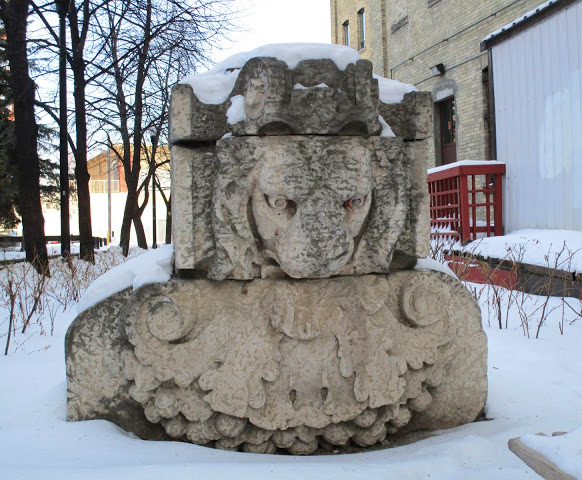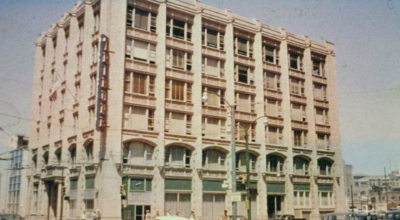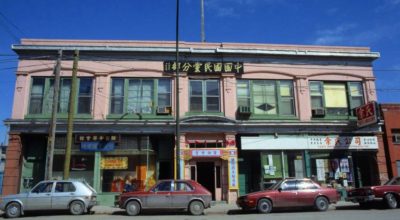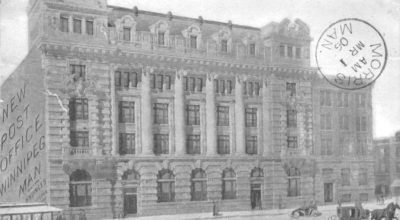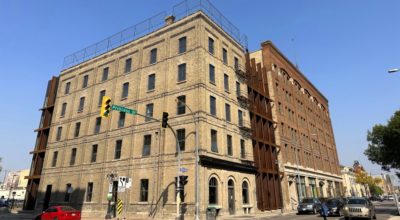
/ Blog
December 3, 2020
John Hirsch Place: Winnipeg’s Wonderful Woonerf
Hidden behind the old warehouses in Winnipeg’s Exchange District is a living street, a back lane reborn as a green and graceful park. There is space for everyone and everything, from people and cars to plants and performances, all harmoniously sharing the roadway. What was once a part of an crucial transportation network that allowed Winnipeg to transform into a world class metropolis at the start of the 20th century, is now leading the way in innovation at the start of the 21st century. By embracing our heritage and the natural environment, a pedestrian friendly space has arisen in the most unlikely of places, while still making room for cars. Shady benches invite you to stop for a rest in the summer, thoughtful lighting entices you to stay out a little later in the evening while quiet solitude protected from the wind make it the perfect place for a winter stroll. It is the kind of place where people want to be, the kind of place Winnipeg needs more of. It is John Hirsch Place.
Winnipeg’s Exchange District was made possible by the arrival of the transcontinental Canadian Pacific Railway in 1881. Connected to the world; money, goods and people flowed in, taking Winnipeg from backwater to wow in less than two decades. A frontier town full of ambitious business men looking to make their fortune, they shrewdly lobbied the railway for special shipping rates for Winnipeg in 1886 and 1890, making it the ideal place for new businesses to open up shop. And so sprang up the warehouses of the Exchange District. The opening of the Winnipeg Grain and Produce Exchange in 1887 only further cemented Winnipeg’s place as a center of commerce in North America. Grain arrived from the west and goods arrived from the east, being bought, sold and reshuffled in Winnipeg before heading out to other markets. By 1890, the Exchange District was home to 12 rail lines and over 80 wholesale business. This would explode to 24 rail lines and over 200 wholesale business in 1911, when Winnipeg was the third largest city in Canada and one of the largest railway hubs in the world. Housing, banks, theaters, publishers, hotels, offices and more – the Exchange District had it all!
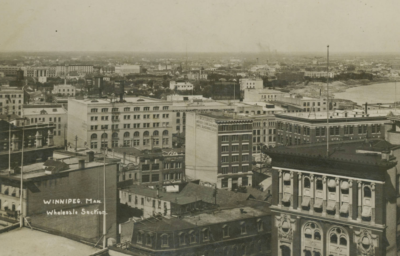
The warehouses of the East Exchange District around 1910, looking north.
Source: PastForward
To serve the warehouses of Winnipeg Exchange District, the Winnipeg Transfer Railway Company was created in 1889 with the task of building a railway along the west side of the Red River, connecting the Canadian Pacific Railway main line at Point Douglas Avenue to the Northern Pacific and Manitoba Railway at Water Avenue. Called the Winnipeg Transfer Railway Spur Line, it took about five years for the tracks to be completed. Along with following the river, short spur lines branched off into the East Exchange District, running between the existing streets to service the backs of buildings, much like how a back lane would function today. The Spur Line was a real draw for businesses, with an enthusiastic James Ashdown starting construction on his warehouse at 167 Bannatyne Avenue, promptly after the tracks were laid down behind the lot.
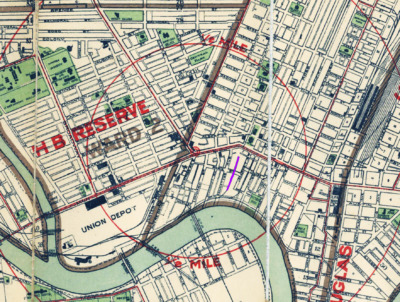
Map of downtown Winnipeg in 1910 (Portage Avenue and Main Street at the center), with the spur line that would become John Hirsch Place highlighted in purple.
Source: North East Winnipeg Historical Society
The onset of the First World War and the opening of the Panama Canal changed Winnipeg forever, with its economy grinding to a halt and struggling to ever recover. Winnipeg’s warehouse district became a ghost town, with no one having enough funds to demolish the buildings, never mind replace them. The 1960s saw Winnipeg Mayor Steven Juba attempt to revive Winnipeg’s downtown using the latest urban renewal strategy: demolish everything old and building anew, correcting the mistakes of a city that had been allowed to grow up organically. The Exchange District was identified as an “area of blight”, ready to be demolished and reborn as a modernist city. But finances forced the grand plan to be greatly scaled back, seeing only the City Hall, market building, Fire Hall No. 1, and 180 acres on the east side of Main Street, across from City Hall, demolished. These buildings were replaced with a new civic complex on the west side of Main Street and an arts and culture hub on the east side. Ironically, this new modern architecture constructed in the 1960s, including the Public Safety Building and Centennial Concert Hall, are now considered valuable built heritage!
Fortunately for the rest of the Exchange District, the wrecking ball never arrived. The early 1970s saw Winnipeg sink into a recession while the mid 1970s saw a burgeoning interest in Winnipeg’s built heritage. Two studies of the Exchange District took place, with the National Trust for Canada putting $500,000 towards its conservation, with the stipulation that the city match the funds and legislate protection of the area. Public perception of built heritage was also changing, with heritage advocates taking to the streets to protest the demolition of buildings that could have been purchased for only a dollar less than a decade prior. In 1978 the city’s first heritage bylaw was enacted, yet another sign the tide was starting to turn for the Exchange District.
In 1987 the City of Winnipeg purchased the spur line running between Market Avenue and Bannatyne Avenue. The tracks were replaced with a service road, eventually named John Hirsch Place, while the Exchange District continued to slowly reignite. In 1997 it became a national historic site of Canada, recognized for its role in the development of western Canada and the multitude of intact turn of the century warehouses. In 2004 revitalization efforts paid off in the East Exchange District, with the first major commercial and residential development in nearly a century taking place. With more and more people calling the East Exchange home, a ten year plan for the North East Exchange was completed in 2014, looking at both infrastructure and urban design. And from this new plan, a woonerf was born!
“Woonerf” is a Dutch word meaning living street. The idea of bring a street to life was first implemented in the Netherlands, where it is not hard to imagine a bicycle crazed nation choosing to demote cars. But understanding that a city without cars is not practical, a woonerf is a shared space, designed primarily for pedestrians but with room for cars when required. The division between park, sidewalk and road melt away, calming traffic and encouraging human activity. It captures the ideals of a modern, human centric city with safe, vibrant streets.
John Hirsch Place was chosen to be Winnipeg’s first woonerf, a demonstration project that could spur the creation of more progressive street redevelopment. The former railway line had become an unsightly back lane with dumpsters for landscaping and no regard for pedestrians. But it was also surrounded by interesting historical buildings in a neighborhood focused on active transportation. HTFC Planning & Design and WSP Canada Group Limited worked in collaboration with the City of Winnipeg on the redesign, taking the once vital transportation artery that had fallen on hard times and making it desirable once again. From the lighting to the drainage, no detail was overlooked by, including the area’s heritage. Long ago filled in, Brown’s Creek which once ran through the Exchange District, is alluded to with a rippling lighting effect on the sides of buildings and the wavy choice of pavers. Existing trees were maintained while space for community gardens was added. Seating, bike racks, event space, commemorative plaques, pedestrian scale lighting, landscaping and parking were interwoven along the edges, while a pedestrian link to Waterfront Drive was created. Winnipeg’s peaceful woonerf is nothing short on an oasis, connected, accessible, well light and safe to enjoy in all seasons, an exciting example of the adaptive reuse of an historic landscape.
In addition to the street being lined with five historic warehouses, the Marshall Wells Hardware Warehouse at 136 Market Avenue, the Great West Saddlery Building at 113 Market Avenue, the Bright and Johnston Building at 141 Bannatyne Avenue and the Marshall Wells Warehouse at 123 Bannatyne Avenue, Winnipeg’s woonerf holds one more historic secret. At the eastern end of John Hirsch Place, where the road gently leads vehicle traffic back to Bannatyne Avenue and only pedestrians can continue on, two glorious loin heads carved from limestone sit regally in the shade. They are shards from the facade Royal Alexandra Hotel, architectural salvage from a past century. The Royal Alexandra Hotel was located at the north east corner of Higgins Avenue and Main Street, built in 1906 by the Canadian Pacific Railway. It reigned supreme as one of the finest hotels in western Canada, named after the wife of King Edward VII, it played host to both King George VI and Queen Elizabeth II (three times!). Designed in the beaux-Arts by Edward and William Maxwell, the grand building was constructed of eye catching red brick from Wisconsin and stately limestone from Manitoba. The landmark hotel only stood for 65 years, having spent the final four years of its life empty. In the era before heritage designations, there was nothing standing in the way of the wrecking ball. Fortunately, Alexander Billinkoff, the owner of the company which demolished the building, saw fit to salvage the carved limestone lion heads on the facade and donated them to the City of Winnipeg. While there are two lions located on John Hirsch Place, a third shard from the hotel can be found in the English Garden at Assiniboine Park. Given the amount of ornamentation visible on the facade of the hotel in pictures, there is not doubt that there are more shards from the historic building hidden away somewhere in Winnipeg.
John Hirsch Place is a amazing example of what can be achieved when both the past and the future are embraced, all while remembering that cities should be built for people, not cars. Its willingness to intertwine the past with modern technology and ideals has created a memorable space with a scene of place, drawing people in and enticing them to stay awhile. It tells the story of the railway and the rise of Winnipeg, accommodates Winnipeg’s passion for parking and provides space for the community to gather. The design emphasizes quality over quantity, addressing the community’s needs and setting an example for the future. The design of John Hirsch Place was an important part North East Exchange District Public Realm project that won a National Urban Design Award in 2020 from the Royal Architectural Institute of Canada.We can only hope that the city deems the historic John Hirsch Place a success and there are many more wonderful woonerf in ready to celebrate the past in Winnipeg’s future!
THANK YOU TO THE SPONSOR OF THIS BLOG POST:

Written by Heritage Winnipeg.
SOURCES:
Canada's Historic Places | Exchange District National Historic Site of Canada
CBC | 'Absolute travesty': 1960s plan called for demolition of Winnipeg's East Exchange District
CHVN Radio | New pedestrian-friendly street brightening up Winnipeg's Exchange District
Citygreen | John Hirsch Place – Winnipeg’s First Woonerf
City of Winnipeg | The Exchange District National Historic Site
City of Winnipeg, HFTC Planning & Design | Zoning for Soul – East Exchange District, Winnipeg
City of Winnipeg, WSP, HTFC Planning & Design | North East Exchange District Enginering Study
Manitoba Historical Society | Royal Alexandra Hotel Shard (Assiniboine Park, Winnipeg)
Manitoba Historical Society | Sinclair’s Creek (Winnipeg)
Manitoba Historical Society | Winnipeg Transfer Railway Spur Line (Winnipeg)
National Post | Info Booth: What exactly is a woonerf, anyway?
North East Winnipeg Historical Society | Area Histories: Historical Maps
Peterson, M. | 130 Galt Avenue (95 & 115 Alexander Avenue)
RAIC | National Urban Design Awards — 2020 Recipient
Sandy James Planner | The Woonerf Arrives in Winnipeg
Spectator Tribune | Lost Winnipeg: The Royal Alex
Winnipeg Places | Old Market Square






